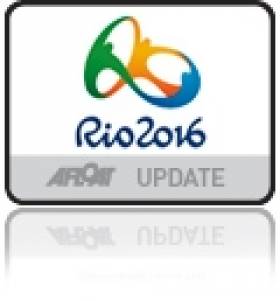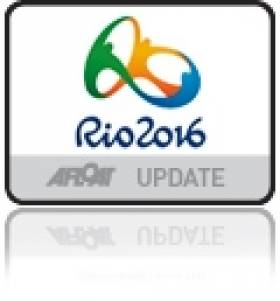Displaying items by tag: World Rankings
ISAF World Sailing Rankings Released, Annalise Murphy Ranked 15th
#isaf – The ISAF World Sailing Rankings for 2 February 2015 have been released. Irish Laser radial sailor Annalise Murphy, who placed seventh overall in Miami last week, is ranked 15th, Belfast's lough's Ryan Seaton and Matt McGovern are world ranked 16th in the 49er skiff and club mate James Espey is 45th in the mens Laser division. Full rankings in all classes are here.
Laser
By his own standards, Tom Burton (AUS) was off the pace at ISAF Sailing World Cup Miami, Presented by Sunbrella, finishing down in 18th. However with a number of medal winning performances already behind him, he holds on to World #1.
Philipp Buhl (GER) claimed the World Cup Miami title but only after his nearest rival Nick Thompson (GBR) suffered an equipment malfunction that allowed the German to pass in the Medal Race. Buhl's victory gave him the full 200-points and he leapfrogs up from World #30 to World #7.
Thompson meanwhile moves up to World #2 as Robert Scheidt (BRA) slips to World #3.
Miami was a vital regatta for all of the competitors with valuable ranking points up for grabs. A top performance would prove significant and that was certainly the case for the 14th placed Jesper Stalheim (SWE) and the eighth placed Rutger van Schaardenburg (NED).
Stalheim picked up 175 points whilst van Schaardenburg received 186. They move back into the top 30 at World #20 and #21 respectively, securing an invitation to ISAF Sailing World Cup Hyères.
Alex Mills Barton (GBR) and Kristian Ruth (NOR) also sneak into the top 30 at World #29 and World #30.
Several 50-point regattas across the world also see chops and changes in the middle of the rankings.
Laser Radial
There is no change to the leading Laser Radial trio with the Miami podium finishers all solidifying their top position. Bronze medallist Marit Bouwmeester (NED) sits at World #1, silver medallist Evi Van Acker (BEL) is at World #2 and Anne Marie Rindom (DEN), Miami gold medallist, completes the top three.
There are plenty of movers and shakers below them with the 200-point ISAF Sailing World Cup Miami and several 50-point regattas ensuring so. With the top 30 receiving invitations to ISAF Sailing World Cup Hyères, the fight for position in Miami was fierce.
Alison Young (GBR) moves back into the top 30 after a busy period of racing. Wins at ISAF Sailing World Cup Melbourne and Sail Sydney combined with a ninth at the ISAF Worlds and a fourth at the Sailing World Cup Final had left her at World #38. A hard fought fifth in Miami pushes her back into the top places and she sits at World #18.
At the cut off point for Hyères invitations, Joyce Floridia (ITA) and Fernanda Decnop (BRA) both move into the top 30, counting the key points they secured at World Cup Miami. For Paloma Schmidt (PER), a 45th in Miami was not enough to solidify her position in the top 30 and she misses out by four points.
Finn
Ivan Kljakovic Gaspic (CRO) retained World #1 in the Finn following a silver medal performance at ISAF Sailing World Cup Miami. The Croatian has three consecutive second place finishes to his name, ensuring a sublime haul of points.
Giles Scott (GBR) holds a perfect ranking score of 800 points after he extended his winning streak in Miami. However, the Briton only counts five regattas to his ranking whilst those around him count six. Scott is positioned at World #7.
Zsombor Berecz (HUN) moves back into the top 30 after he won gold at the 50-point Palamos Christmas Race at the back end of 2014. The current World #30 takes the final Hyères invitation. Palamos silver medallist Milan Vujasinovic (CRO) also moves into the top 30. He is at World #20.
49erFX
Having dominated the 49erFX over the last 12 months, Martine Grael and Kahena Kunze (BRA) comfortably sit atop of the rankings on 988 points.
North American gold and a World Cup Miami bronze ensured their position was solidified and they are 69 points clear of World #2 Ida Marie Baad Nielsen and Marie Thusgaard Olsen (DEN).
Alex Maloney and Molly Meech (NZL) finished second at the Midwinters before sealing World Cup Miami gold with a day to spare. With the full 200 World Cup points coming their way they move up to World #3.
Interestingly, since the 49erFX's first ranking release on 12 December 2012, there have only been two World #1s, the Brazilians and Kiwis. But as crews continue to master the equipment, they'll look to spring some surprises on the road to Rio.
Tess Lloyd and Caitlin Elks (AUS) took the honours at the Oceanic Championship and continue to march up the rankings. They move up four places to World #14.
49er
ISAF Sailing World Cup Miami bronze was enough for Jonas Warrer and Anders Thomsen (DEN) to retain World #1 in the 49er. Joel Turner, sailing with Iain Jensen, picked up silver in Miami and as a result Turner moves from World #40 to World #18 and will receive a Hyères invitation for himself and usual crew Lewis Brake.
Turner came in for Nathan Outteridge who missed out on Miami competition for personal reasons. Jensen will revert back to sailing with his usual helm. Outteridge and Jensen sit at World #24 but only count four regattas to their point's total.
Nico Delle Karth and Nikolaus Resch (AUT) put together a steady string of Miami results that ultimately handed them the title. They did not win a race across the series of 13 but 11 top ten performances gave them the edge. They remain at World #3.
A 23rd in Miami was enough for Federico and Arturo Alonso (ESP) to re-enter the top 30 at World #27. Jacapo Plazzi and Umberto Molineris (ITA) move to World #30 after a 31st in Miami. Both crews will receive invitations to ISAF Sailing World Cup Hyères.
Men's 470
Mat Belcher and Will Ryan (AUS) retain World #1 in the Men's 470 after two medal winning performances in Miami, USA. They claimed the North American title in advance of ISAF Sailing World Cup Miami but were made to settle for silver at the main event. They sit 25 points clear of World #2 Panagiotis Mantis and Pavlos Kagialis (GRE).
Luke Patience and Elliot Willis (GBR) finished behind the Australians at the 100-point North American regatta but had their revenge by securing a seven point victory at World Cup Miami. As a result they shift up to World #3.
Japan's Tetsuya Matsunago and Yugo Yoshida are the big movers this month. The Japanese pair picked up bronze at the 470 North Americans before sealing a tenth at World Cup Miami. As a result, they have moved up to a personal best of World #5 from World #19.
Palamos Christmas Race silver medallists Guillaume Pirouelle and Valentin Sipan (FRA) sneak into World #30, thus securing an invitation to World Cup Hyères. At World #31 Antonio and Joao Rosa miss out on an automatic invitation by 24 points. Their chance to qualify will come at Princess Sofia Trophy regatta in Palma, Mallorca, Spain.
Women's 470
New Zealand's Jo Aleh and Polly Powrie move back to World #1 in the Women's 470 having dominated ISAF Sailing World Cup Miami, Presented by Sunbrella. Taking the full 200-points the Kiwis are 99 points clear of Fernanda Oliveira and Ana Luiza Barbachan (BRA).
Hannah Mills and Saskia Clark (GBR) finished 27 points off the Kiwis in Miami, however with a silver medal coming their way they move up to World #7 from World #21.
Lara Vadlau and Jolanta Ogar (AUT) took the gold at the 100-point North American Championship in advance of their ninth at the World Cup. They sit at World #11.
France's Maelenn Lemaitre and Aloise Retornaz took 50-points away from the Palamos Christmas Race regatta at the end of 2014 and remain at World #24.
There are no shock entries into the top 30 after many of the leading teams used Miami to solidify their spot top 30 status.
Men's RS:X
It was an up and down week in the Men's RS:X, with consistency a rarity on Miami's challenging track. Nonetheless, the form racers came to the forefront.
Dorian van Rijsselberge (NED) claimed gold which promotes him up to World #13 from World #29. Silver for Thomas Goyard (FRA) moves him up to World #3 a personal best and bronze medallist Byron Kokkalanis (GRE) retains World #1.
Sebastian Fleischer (DEN), Joan Cardona Bocarando (ESP) and Ivan Pastor (ESP) all move into the top 30 after solid Miami performances and subsequently qualify for ISAF Sailing World Cup Hyères.
The 100-point RS:X African Championship title went the way of Algeria's Hamza Bouras. The Algerian moves up to World #105, a personal best.
Women's RS:X
Flavia Tartaglini (ITA) holds on to World #1 in the Women's RS:X in spite of a disappointing final day in Miami. The Italian was on the course side in the Medal Race and dropped out of the honours. Nonetheless her fourth place was enough for her to retain her position at the top of the rankings.
The Netherlands' Lilian de Geus and Russia's Olga Maslivets were major benefactors of Tartaglini's downfall. De Geus took silver which pushes her up to World #4, a personal best, and Maslivets' bronze sees her climb up to World #25 from World #38 to secure a Hyères invitation.
Bryony Shaw (GBR) claimed a comprehensive Miami victory, solidifying her spot at World #2.
Nacra 17
Vittorio Bissaro and Silvia Sicouri (ITA) successfully defended their ISAF Sailing World Cup Miami title with a day to spare. By taking maximum points at the 200-point regatta they hold on to World #1.
Ben Saxton and Nicola Groves (GBR) took silver in Miami and remain at World #6. Billy Besson and Marie Riou (FRA) sneaked onto the Miami podium and sit at World #2.
Mandy Mulder and Coen de Koning (NED) finished fourth, moving them back into the top 30.
Seaton & McGovern's Silver Medal Moves Irish Skiff Sailors From #30 to #11 in World Rankings
#irish49er – Ireland's Ryan Seaton and Matthew McGovern sailed with intent and focus in Hyères and came away with their first ever ISAF Sailing World Cup medal on Saturday. Their silver medal earned them a good point's haul and pushed them up from World #30 to World #11.
Peter Burling and Blair Tuke (NZL) have four straight regatta victories in the 49er fleet and are currently at World #16 as those around them count points from six regattas.
The Kiwis took convincing victories at ISAF Sailing World Cup Mallorca and Hyères and are in a good place in advance of the 2014 49er European and ISAF World Championships.
Jonas Warrer and Peter Lang (DEN) top the pile on 960 points. Over the 12 month period the Danes have posted consistent top placed results. A gold in Miami and silver in Mallorca puts them in a good place.
The latest world rankings from ISAF are here.






























































